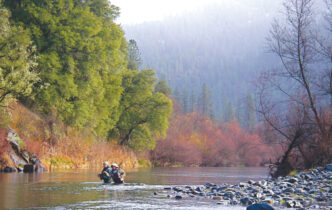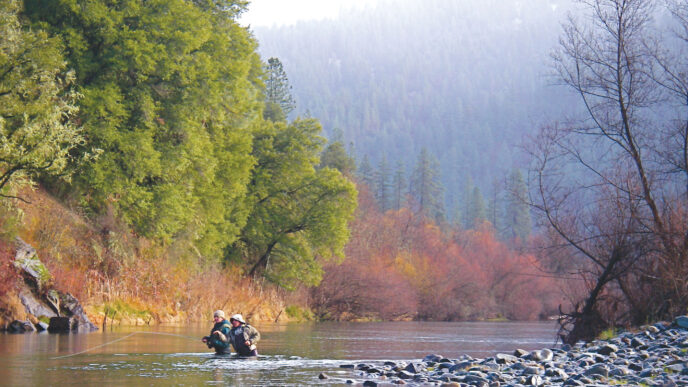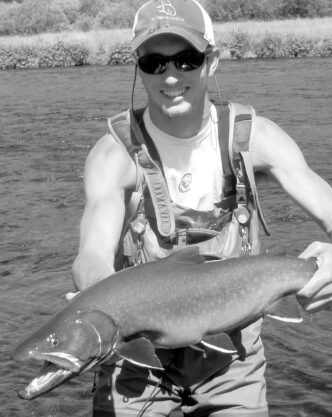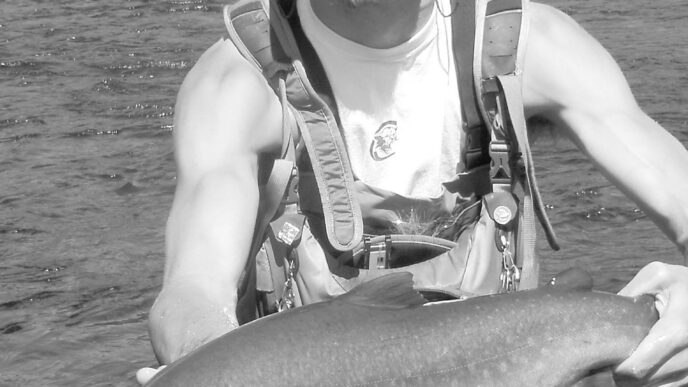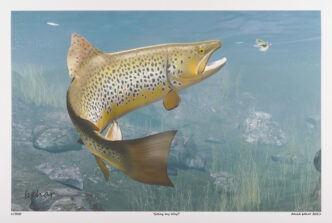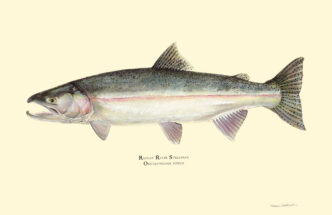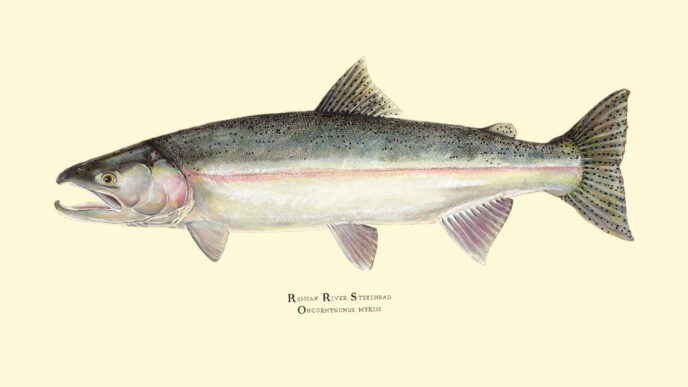Part the First
It was an awfully bright moment in the early 1990s when Nick Lyons called this magazine “a happy, maverick publication.” At the time, Lyons owned the most respected book-publishing house in American fly fishing and had personally shepherded to print many classics of an entire fly-fishing generation. To this day, he has an unmatched reputation for integrity and vision.
So, praise from Nick Lyons? Bright moment. More brilliant because if California Fly Fisher had already attracted national attention, it was mostly from out-of-state relatives of the magazine’s staff. Since the magazine had no “staff ” per se, you get the idea.
But you know, that word “maverick” does stand out, and it still applies.
One might argue, rightly, that it fits the philosophy of an editor who intended to present the best and best-written material he could find to the largest, most experienced, most passionate, independent, innovative and — until then — routinely ignored group of fly-fishing readers anywhere. This column’s writer would assert just that, except that the same editor is ludicrously touchy about people presuming to know his beliefs and intentions, and woe to any scribbler who dares to identify him as a “character” in a way that might seem like a promotion that transgresses the traditional good manners and polite mysteries of magazine production intended to protect readers from gross egoism and product propaganda. (Oddly enough, or perhaps not, this resistance is today pretty “maverick.”)
So let’s pass on that assertion right now. We might instead speculate that Lyons meant to acknowledge articles and essays that sometimes so blithely have ignored conventional formulas that a few readers might have imagined the authors never learned them. (Several said so.) But how much more gratifying would be another interpretation: that the term “maverick” describes a raked-hat, silver-rod-seat-butt-capped daring that has invited readers to explore and appreciate Wild Wild West waters unknown east of the Owens, to tie and cast flies designed by too-little-known California masters, introduced first on these pages behind illustrations by Barry Glickman. Along with locations and flies came new tactics: Ted Fay’s high-stick nymphing, for example, which angler’s in other parts of the country believe was recently “discovered” in Eastern Europe. To that, I would add, just for fun, an obscure method revealed in an early issue, although not yet really revived, resurrecting the very first fly-fishing technique employed in North America: a Seminole Indian practice of catching bass above the water using flies tied to resemble birds, the source, but not the timing, lately debated.
Of course, there was another territory that California Fly Fisher pioneered, more perilous than any — truly a never never go there land. But before we gird our loins and loinettes to go there again, it seems only appropriate to observe that original ideas first seen here and a fair number of folks first read on these pages have gone on to gather kudos across the nation and the world.
Self-serving? You bet. And while readers might or might not excuse this preamble, the secret hope of this writer is that it might serve as a prophylactic designed to avert outrage at our boldest move yet, a real loinbuster, and as a complicated way of saying “Don’t hit me” as we break new ground and wind to open a wide sky of possibilities that would daunt Galileo.
You remember Galileo — he was right about the Earth and the Sun and all that. Also that he recanted under threat . . . which should be an option here, I know all readers will agree.
Why this latest bold and groundbreaking move? Because we’re maverick, that’s why. Because “Meander” means that, and it’s not a serious word. Because what follows is so true to deeply American principles and the spirit that made this country great. Also, because a lot of us like dogs. And finally . . .
Because it’s about tarpon. I don’t think you suspected that.
Part the Second: California Facts and Our America
The breadth and depth of California angling opportunities are due to its length, long ocean coast, and extraordinary range of altitude and varieties of climate located on public land. Like it or not, we must also credit the blithe and, in hindsight, blindly oblivious invitations extended to nonnative species by official agencies, also by a few twits competing for the most destructive of Darwin Awards. In addition, the laudable efforts to keep waters healthy by many readers, writers, and editors of this magazine have benefited several aliens, including European brown and eastern brook trout, striped, smallmouth, and Florida largemouth bass, American shad, several species of carp, verminous, but tasty yellow perch, and those goddamn northern pike.
Other invaders are known and suspected, and more are surely on their way. The narrow and selfish sport-interested point here is that California has as many freshwater game fish as an area with two senators can expect, including several “best anywhere” fisheries; also saltwater beasts that fly fishers are just getting to know.
This magazine has always recognized and celebrated that diversity. However often editors, writers, and readers champion natives first, with wild as a guilty second choice, we have with a few virulent exceptions embraced the spirit of Lazarus — Emma, I mean — those sentiments imbedded on a tablet of a large French sculpture towering above some fair to good striper rips in New York Harbor. If it happened that said world sent us finned huddled masses that propagated awfully quickly for a supposedly “weary” bunch and that some of the “wretched refuse” of other shores proved only happier refuse when they arrived, our unspoken attitude is “They’re here, so let’s catch ’em.”
Longtime California Fly Fisher readers know we’ve taken grief for our courageous or mercenary championing of these species — often from those readers themselves. That includes snarky remarks about anything not salmonid — those bass, for example, and no doubt jacksmelt, corbinas and corvinas, bonitos, albacore, and other species with names less rhythmic and easy to alliterate. But lest we forget: Our March/April 1997 cover and article preceded by years what’s now a nationally trendy pursuit of “golden bonefish,” was banned from the stands of several shops, and the earnest writer was politely abused in person almost three times — once while only half sober — though he certainly holds no grudges.
Even so, did we miss a beat? Not one.
Not many, anyway.
Not yet.
Part the Third: But We Still Don’t Have Tarpon
According to a poll almost taken of loyal California Fly Fisher readers, two fish found elsewhere in the United States, but not in the Golden State, create 73 percent of angler envy. By “envy,” I also mean agonized yearning, those wish-I-could-fish fugues that stress family life. But if there are really bonefish in a bay just south of San Diego? That leaves only one.
Ooooo, but that one.
It so happens that I have too often mourned the Great Tarpon Omission, even more as I age, and that I have twice cried out to others, “What was your God thinking, to leave us without?” because my God hasn’t returned calls since that teensy misunderstanding in 1986. Most often, my tarpon angst arises when I am asked to review books or films shoving paeans to “the World’s Greatest Game Fish” down my throat. I suppose that’s happened five times in the last ten years, but it is getting worse: Tarpon the movie, with Jim Harrison, Richard Brautigan, and Tom McGuane, for example, shot in 1972 and excavated several years ago, reeled off sequences that could leave a clinically dead fisher more breathless than ever. Came then Andy Mill’s $100 tome A Passion for Tarpon, a spectacularly illustrated history and surprisingly detailed how-to. Surprisingly detailed. Flies, tackle, knots. Tips about stalking, casting, hooking, and fighting an animal weighing a hundred pounds. It’s a challenge to critique advice about an activity you’ve never done, but so much of this seemed like preparations you could make in your garage. Familiar stuff, almost, until you hit a bit like “bowing” to the fish. Imagine that — bowing, no less.
Bow. Wow.
“I’ve written a sidebar to a book review,” I e-mailed the editor a few days later. “But it’s really a ‘Meander.’ ”
“I think you’re right,” he wrote back.
So —
Bow wow.
Part the Fourth: Silver King, Meet Golden Retriever
The rod’s an 11-weight I loved casting the one time I had a chance — for sailfish, roosters and dorados — way down in the Sea of Cortez. The reel is old, but gleams with provenance, owned before me by Kate and Bill Howe, architects of the ALF pattern. True, my floating line was extruded for tarpon a long time ago, but it is smooth and clean, if a tad bit stiff on a day when frost gilds ferns shadowed by firs and spruce. At least the leader’s fresh, tied as A Passion for Tarpon prescribes. As for the Bimini, knotting it around my knee proved painfully difficult until I realized that when author Andy Mill suggests “twist both legs tightly around each other,” he actually means the ends of the lines. Too late, this time, but after alternating layers of Bengay and Neosporin, I tie on a big brown Cockroach, adapted to a hookless tube style. If I can’t guess what local baitfish this might represent, no matter. It looks good as a mole or vole, sparrow or robin, and will cast just slightly better than any of those, hurled dead or alive.
“So check this out,” I said to my panting partner, preening the feathers of the hookless Roach and letting him sniff. “But remember, this is a professional test: no gnawing, and for God’s sake, don’t swallow the thing. Also, in case I forget, I’m not casting to you, but ‘intercepting your path.’ ” Rascal smiles as he sweeps his tail through a three-foot arc. If not technically a game fish, he’s certainly game. He’s also enormous, the British strain of golden retriever — voracious, smart enough to vote in the primaries of both major political parties, and the only dog I’ve owned that can actually tell a joke with superior timing, although that is a story for another day.
“So you’re going to go long,” I explain. “Past the fire pit, staying clear of the post box. You got that? You ready?”
Rascal won’t go anywhere — his attention’s stuck to the Roach. Or it is until I throw out a fir cone teaser — reluctantly, because I’m sure some purist will complain this is “chumming.”
It does the job, though. Rascal sprints after it. And in the ten seconds this ruse provides — to the end of my back cast as the line loads for a haul — it occurs to me how special this moment is.
Ridiculous, maybe. Lunatic, if you insist. But nobly intended, a reader must admit, which is enough for me. And then, about the time I accelerate the forward stroke — as the Roach whistles safely past a maple — something else occurs to me . . . I am casting a fly to a prey so eager I don’t need no stinking hook . . . a beast willing to fight me for nothing more than his own share of ferocious pleasure.
Makes you think — or laugh. Either way, know this: On a “Bad Dog!” day, Rascal can run down the Kinkaids’ Volvo before it slows for the speed bump down the street, oh yes. And if I can throw him the Roach, avoiding the choking that afflicts the casting of so many tyro tarpon fishers, he will dig. It helps to recall Mill’s assertion, so accidentally relevant now: “Most anglers are decent casters on golf courses and in backyards.”
How true. Even as a breeze blows down from the ridge, I lay out a full fifty feet before expertly shooting my fly “to end up between the [dog’s] eyes, slightly high, and in front of [him] one inch to six feet, depending on a few variables such as [air] clarity.”
Not perfect cast. But I got a pretty fair bounce.
Rascal sees. Does he ever. Even as flakes of crushed cone fall from his mouth, his body tenses from nose to tail. No bow has been strung so tight. And then, because his manners are excellent, Rascal’s stare turns to me. Can I?
I nod. I strip. He holds fast. No, really, Can I?
I nod again. He cocks his head slightly left, because this is clearly too good to be true. I nod again, strip twice, and finally shout the same command I’ve given a hundred thousand fish. “For God’s sake, just take it!”
And unlike so damn many of those fish . . .
I’ve seen Rascal chase bluegill spawn in the shallows, birds in the spring, rabbits all summer, also an in-law’s rat terrier he’s careful not to catch. This time is different. He knows that, somehow. His attack is everything an angler could hope for.
It takes my breath away to see the muscles in his shoulder bunch, then his paws churn out chunks of turf, his tail spread for takeoff.
Tarpon people can talk all they want about the sight of a “bucket mouth,” but listen up: The canines in Rascal’s jaw are real dog teeth, honed and polished by a stupid habit of gnawing on alder — weapons, I mean, that have shredded every year’s Yellow Pages since 2006 and can rip open a fifty-pound bag of Annie’s Organic Lamb and Rice Chow the way I tear off a paper towel. We’re talking a maw that can seize.
And does. No hesitation: My set is superfluous. Rascal’s on, and here’s a fact, boys —
— this ain’t no oversize herring.
Nobody forgets a golden’s first run. The speed. The leaps. The roars — that slam-slam of its head when it feels the tension of the line. Knowing the fly is faux, Rascal cares not, his disbelief suspended so completely that his snarls frighten deer from my house to the main road.
Per A Passion for Tarpon, chapter 11, I lean into the rod. And —y o! — when this does provoke a jump —
— I bow!
— another jump!
— I bow! He runs!
No . . . I mean he really runs! On all fours, though mostly two at a time!
And stops, dead! So suddenly and silently that — ho! — I, too, hear his electronic collar beep!
He feints right! He cuts left. He’s heading toward the Lisa person’s crummy camellias!
“Good Rascal!” I shout. “Wait — no!
Better . . . not!”
I see it happen; I know my dog. At the sound of my voice, Rascal thinks “Fetch? Oh is this fetch?” and instantly responds.
No way I can keep up with the orange blur streaking toward me. No way on
Earth. With a multiplier reel, I couldn’t pick up line fast enough.
“Stop! Go! Back . . . back!”
Rascal does none of the above. Generations of new FedEx carriers have quailed before the charge I face; now I know how they feel. He’s twenty feet from my boots when I sense his intent. “Rascal! No jumping!”
Lord, the speed . . .
At the last possible second, Rascal turns. His tail whips my waist as his feet spray sod and fir needles. A quick reversal — another . . . now he’s racing back across the emerald-green flat, loops of hissing fly line straightening out behind him until, at last, I get him back on the reel . . .
Rascal rocks. His head shake sprains my wrist! And then —
— he falls to earth like a stone. Drops on his belly, chest heaving, the Roach clamped in his mouth like a —
— cigar — and he lies there . . . and laughs. Anthropomorphize, my ass: He laughs. “Rascal?”
He laughs some more. Nods. “What’s so damn funny?”
With his eyes fixed to mine, he drops the Roach between his forepaws.
“Hey. Don’t do that. You don’t let go.” Then he lowers his nose and . . . nudges it.
Once. Again. He tenses his body, stares harder. And suddenly I realize he’s just waiting for me to try to take it away.
“Rascal!” Just try.
Tarpon may sulk. But golden retrievers? They play with you.
“That is not in the book!” I shout. “That is definitely, definitely not . . . in . . . the . . . book.”
Rascal’s not a reader. But I am, with a bigger cerebellum, as evidenced by a thought that went just like this, twice, unfortunately: The toy can toy too, you know, because two can toy, toyer, so . . .
What I say when I clear my mind is this. “Oh no. No, I’m not going to pull. I won’t, so you can wait as long as you want.”
Rascal waits. Five seconds, seven. At ten he gets it. And grins. You don’t think so? Deliberately, so deliberately . . . he puts a paw on the shock tippet and pins it down. (Oh, yes, he does know.) And then, ever so slowly, he takes the fly in his mouth.
And chews.
“No! Bad Rascal. You son of a bitch, don’t you — Rascal! Dammit! You . . . stay! Stay! Don’t you move one inch . . .”
It could have ended there. “Stay” is an order Rascal almost always honors. And he would have this time, I’m sure, leaving me either a marginal success or a failure still vaguely instructive and duly diligent, I think. Except for that “almost” before “honors.”
Like rivers deep and oceans wide, Grand View Lane has moments nobody can predict — times when wild nature, or, in this case our neighbor, Judy, will rise up when least expected: entropy unfolding while holding a small spade.
“You guys!” she shouts from her deck across the street. “You guys are crazy!”
For a moment, everything hangs suspended. That includes my lower jaw, as I perform the slo-mo “Oh-no!” Disney TV movie routine as Rascal stands stock still, staring at the lady he’s loved from puppyhood. The sound of her voice, the sight of Irish hair exactly the shade of his fur, the glorious odor of her gardening shoes —
On his best days, the invisible electric fence barely holds Rascal back, or doesn’t. But now, delighted by a new toy he must show Mistress Jude?
I’m into my backing before he’s crossed the road to leap her ditch. Halfway up her berm, I’m fighting him above the top of my rod. Incredibly, the tippet survives his lunge through a rose bed, then a leap over her low deck fence, a mad scramble over her fence and into a flower box . . . “Rascal, no jumping!” I hear, this time
in a burry alto.
And he’s still on! Judy laughs, and rascal roars, and so do I, and so does the propane truck — oh God, not the propane truck — gunning its engine at the speed bump!
It’s over in seconds. The line doesn’t survive the truck. Rascal’s off. On my knees, I try to fit my first thoughts into song, but “Don’t cry for me, golden retriever” doesn’t work out, scanwise.
That’s all right. I’m okay, eventually, even philosophical. That’s the kind of risk we face in the West, and the way we roll out here, where our flats are bound by forests and deserts, real mountains, city streets, and suburban yards with quake-bent retaining walls — all kinds of Islamoradas, really . . . and we do miss tarpon, remember:
We’re golden.




